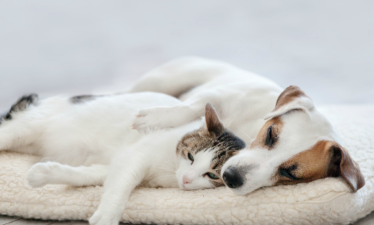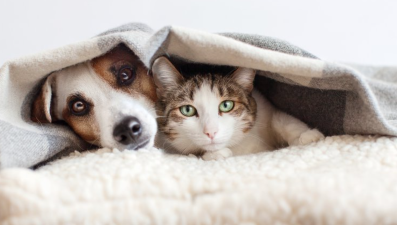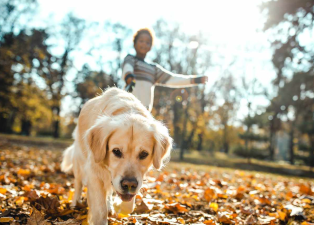How Pet Care Changes in Colder Seasons
With the changing seasons, changes in temperature and environment not only impact human lifestyles but also significantly influence the health and behavior of pets. Whether in terms of diet, exercise, or daily care, pets' needs vary from season to season. As pet owners, we need to adjust our care for our pets according to the seasons to ensure they are healthy and happy throughout each season.
Pay Attention to Food Temperature
In cold weather, the temperature of food you feed your pet is also important. Avoid feeding them food that is too cold, especially food that has just been taken out of the refrigerator. Pets' stomachs are more vulnerable in winter, and eating cold food can easily cause gastrointestinal discomfort, resulting in symptoms such as vomiting and diarrhea. It's best to let food sit at room temperature for a while before feeding your dog or cat, allowing it to warm slightly before feeding.
Seasonal Adjustments to Daily Pet Care

In addition to paying attention to your pet's health, seasonal changes also require corresponding adjustments to daily care. Different seasons require different care priorities, and only by paying meticulous attention can your pet stay in top condition.
- Grooming
Spring molting is a crucial time for grooming. Pets shed a lot of hair during this season. If not cleaned promptly, not only will hair become everywhere in your home, but it can also cause skin problems. Gently combing your pet's coat daily not only removes shed hair but also promotes blood circulation, making the coat shinier and smoother.
- Bathroom Cleaning
During the hot summer months, pets are prone to sweating and odor, so bathing them more frequently is necessary. However, be aware that frequent bathing can strip your pet's skin of its natural oils, leading to dryness. It's recommended to use a mild pet shampoo and thoroughly dry the coat after bathing to prevent moisture retention and skin problems.
- Claw Trimming
The cold, hard surfaces of autumn and winter can easily wear out your pet's claws. Regularly trimming your pet's claws prevents overgrown nails from scratching floors or furniture, and also reduces the risk of your pet tripping due to overgrown nails. Be careful not to cut into blood vessels when trimming to avoid bleeding.
Seasonal Scheduling of Exercise and Social Activities
Seasonal changes not only affect your pet's physical health but also their mental well-being. Appropriate exercise and socialization can help keep your pet energetic and emotionally stable, but these activities may need to be adjusted according to the season.
- Increase Indoor Exercise
With limited outdoor activity in winter, your pet may need less exercise. To ensure your pet's physical exertion and mental well-being, set up some simple toys or obstacles indoors to encourage activities like jumping and chasing. This not only provides physical exercise but also strengthens the bond between owner and pet.
- Outdoor Adventures
Spring and summer, with their pleasant weather, are perfect times to take your pet for walks or trips. Choose scenic parks or the countryside to let your pet enjoy the beauty of nature. However, be mindful of safety when out and about to prevent your pet from getting lost or getting hurt.
- Social Interaction
No matter the season, pets need to interact with others of their kind. Consider joining a local pet club or organizing small get-togethers to give your pet opportunities to meet new people and develop social skills. This not only enriches your pet's life but also helps improve their adaptability and confidence.

Winter Warming Tips
- Keeping Dogs Warm and Clean
With winter creeping in, dogs' paws are susceptible to freezing and accumulating ice and snow after walking on snow-covered surfaces. Failure to clean them promptly can lead to frostbite or infection. Therefore, carefully inspect and gently clean your dog's paws every time you return from an outdoor activity, ensuring they are clean and warm.
- Mistakenly Assuming All Dogs Can Withstand the Cold
Short-haired and small dogs have a weaker resistance to cold, and prolonged exposure to cold temperatures can lead to health problems. Providing a warm bed or, if necessary, warm clothing for your dog is the responsibility of every responsible dog owner. Understanding and addressing the differences in your dog's physical constitution is key to ensuring their winter health.
- High Indoor Temperatures and Neglecting Hydration
Some families turn the heating too high to stay warm, but this can make dogs uncomfortable and even cause dehydration. Maintaining a comfortable indoor temperature and ensuring your dog has access to clean water are key to maintaining their health. Don't let excessively high temperatures become a hidden threat to your dog's health.
- Neglecting winter skin and coat care
The dry climate can cause your dog's skin and coat to become dry and brittle. Regular bathing and grooming not only helps maintain their appearance but also prevents skin problems. Give your dog extra care and attention during the winter to keep them looking their best.
- Reducing your dog's outdoor time
Although winter is cold, adequate exercise is equally important for your dog's health. Reducing outdoor time can lead to weight gain, depression, and even negative effects on their mental health. Therefore, even in cold weather, ensure your dog has adequate outdoor time and reward them appropriately for exercise to motivate them. Let them release their energy through exercise and enjoy the joys of winter.
- Neglecting your dog's winter energy needs
Dogs need more nutrients in winter to maintain their body temperature. Feeding them a summer diet can lead to nutritional deficiencies. Choosing a high-protein, nutritionally balanced dog food is an effective way to meet your dog's winter energy needs. Pay attention to your dog's diet and provide them with adequate nutritional support to keep them strong and healthy for the challenges of winter.


